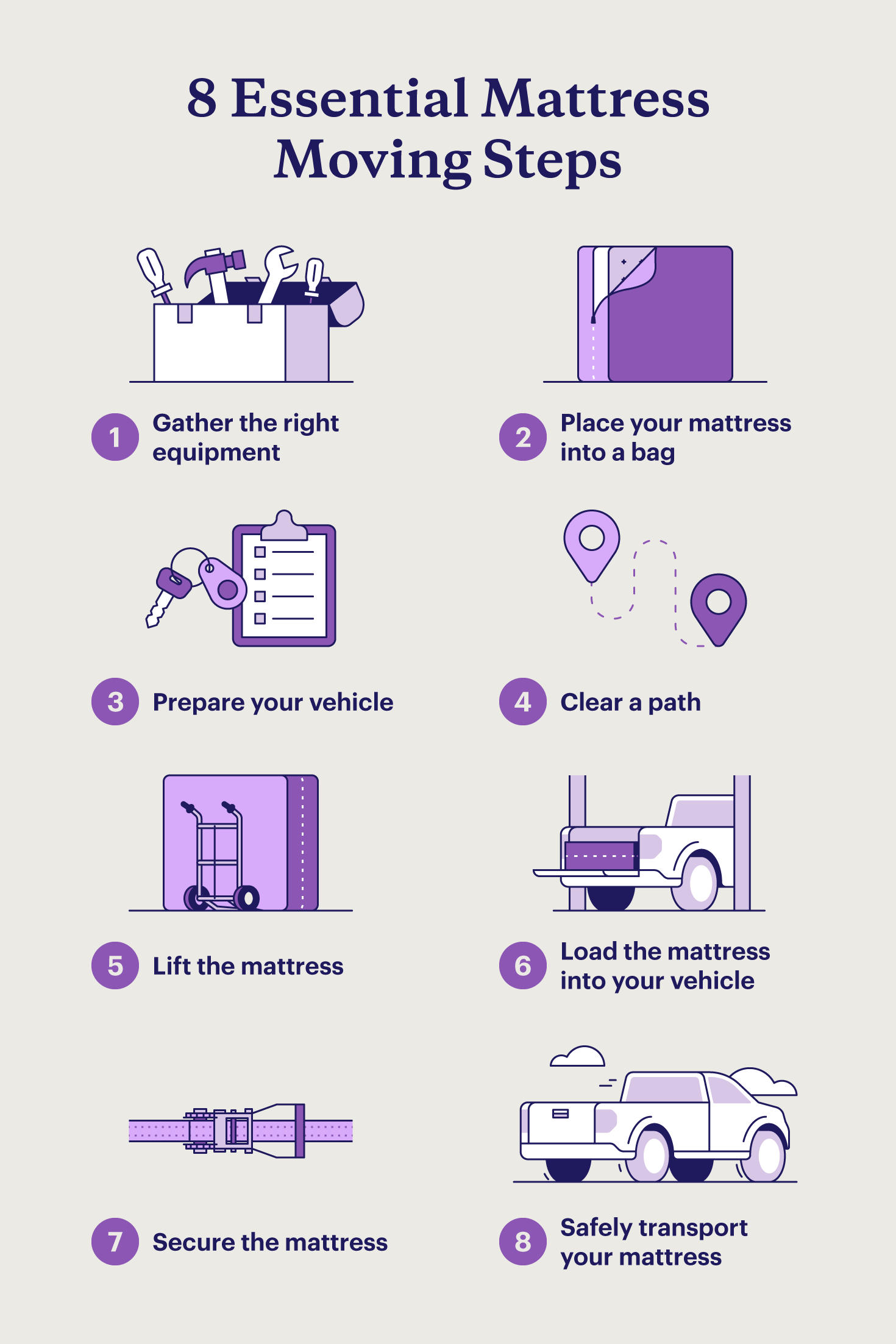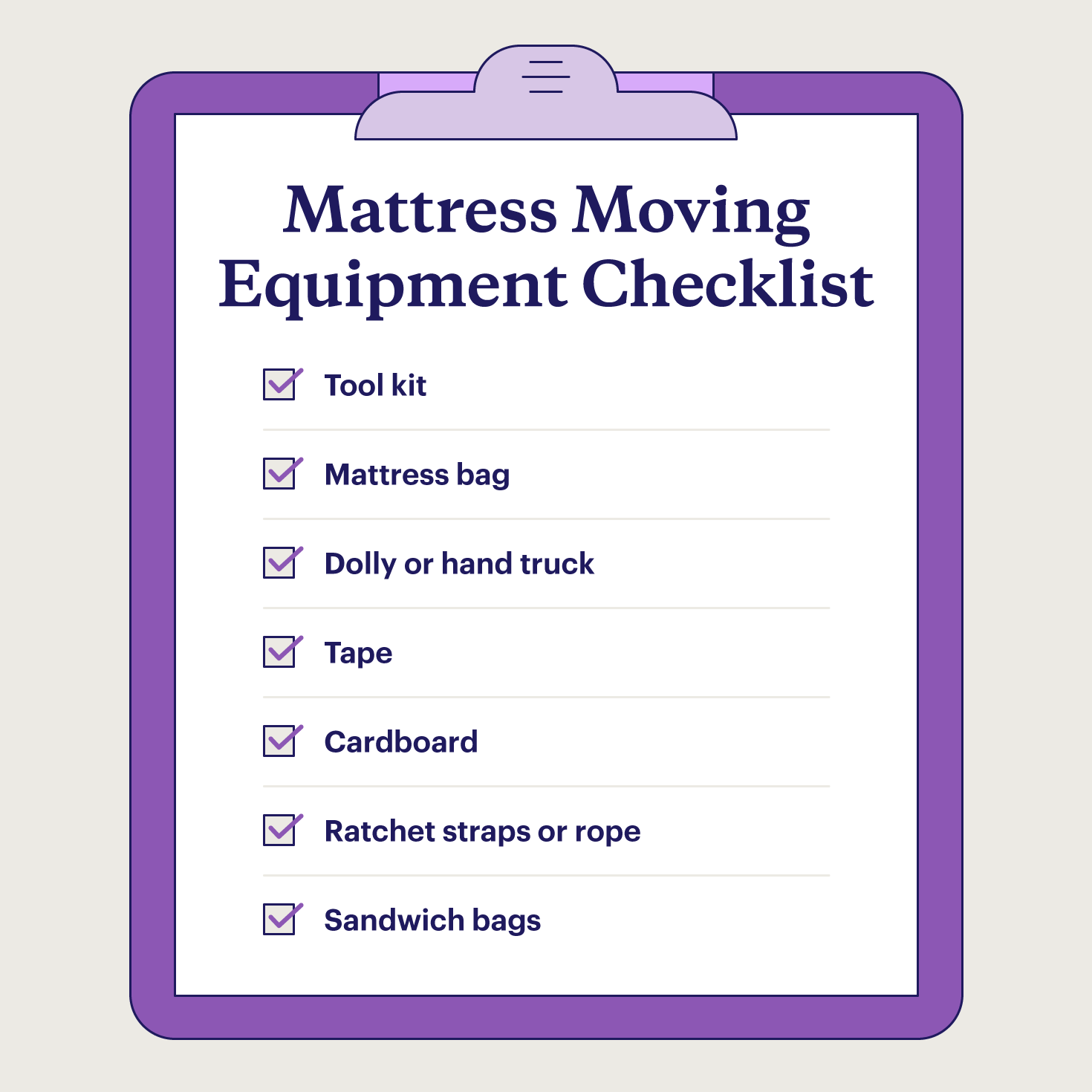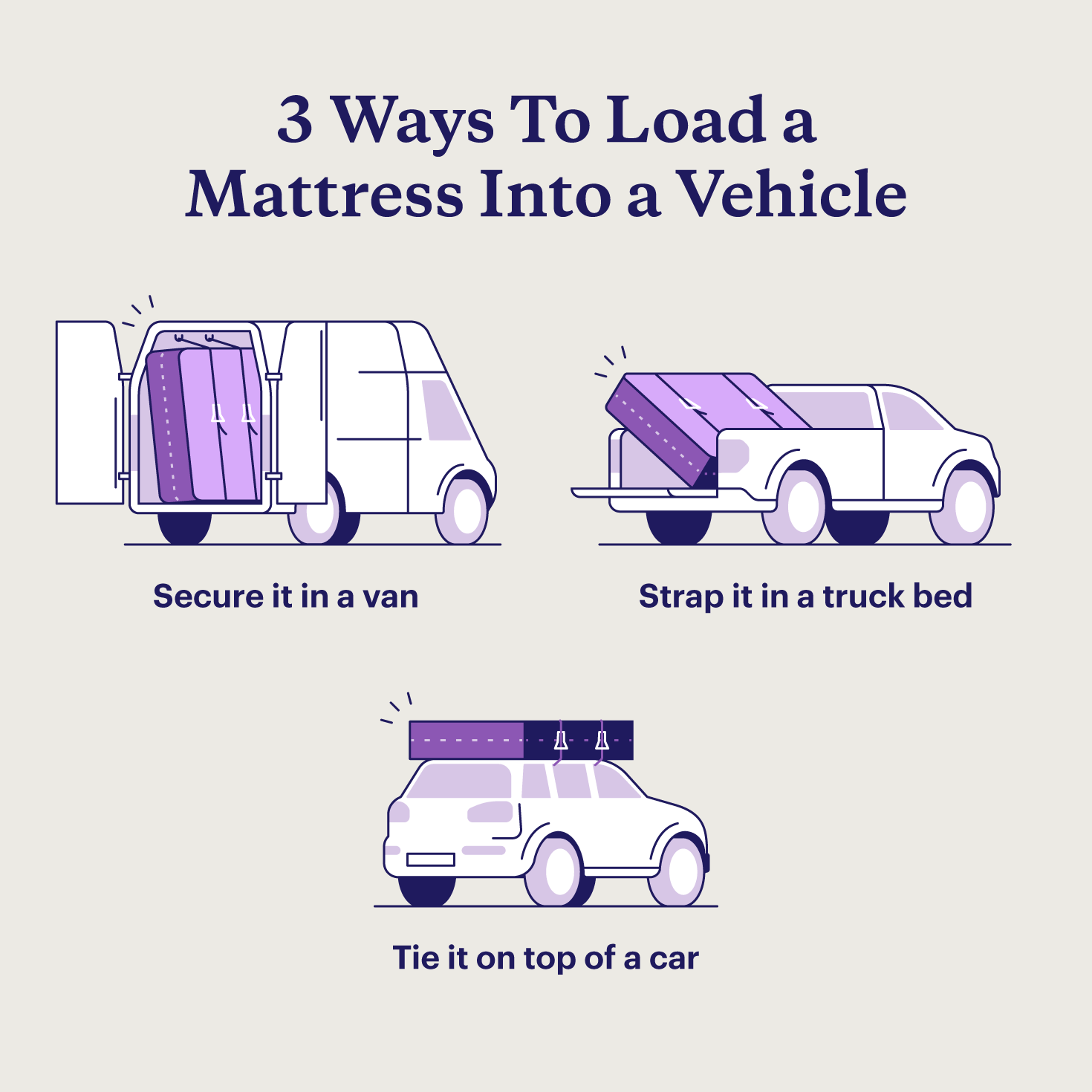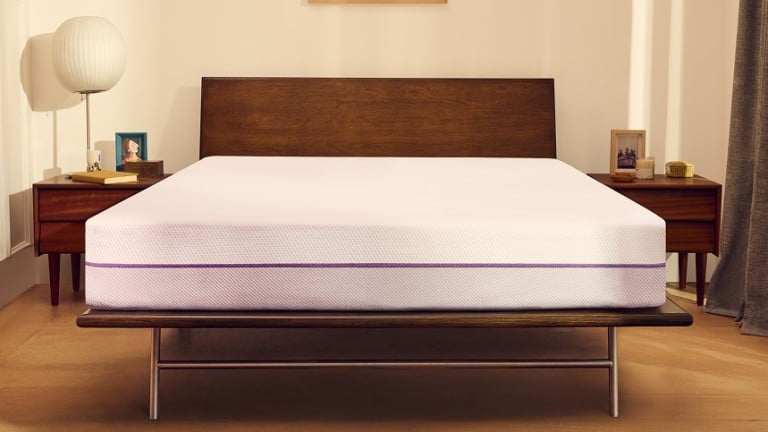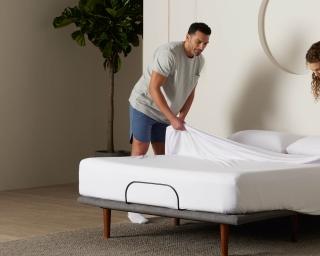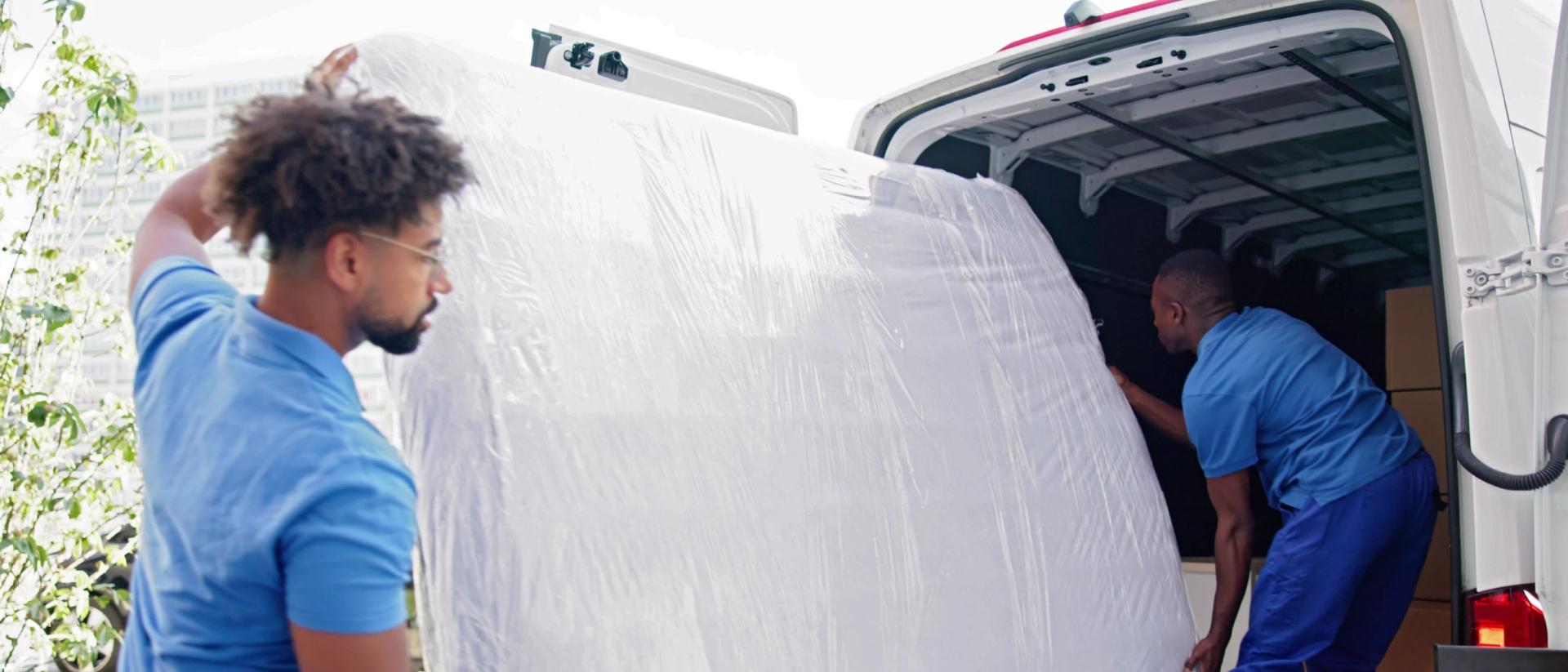
How To Move a Mattress in 8 Simple Steps (+ Tips for Moving a Mattress Yourself)
Key Takeaways:
- Gather the right moving equipment, including a mattress bag, dolly, and ratchet straps.
- Put the mattress bag on and prepare the moving truck or car.
- Clear a path and lift the mattress using a dolly or furniture straps.
- Load the mattress into the vehicle and secure it on its side or flat.
Whether you’re moving across the country or just down the street, lifting a 150-pound mattress can be a daunting task. Maneuvering through doorways, lugging it up and down stairs, lifting it into a truck — you’re probably sore just thinking about it. Don’t worry just yet! Learning how to move a mattress properly can help you avoid the moving pains of relocating or buying a new mattress.
While mattresses can be heavy, there are some simple steps you can take to ensure moving your mattress goes smoothly — whether you’re transporting it by yourself or with the help of a team and truck. After all, the last thing you want is to damage your mattress or strain your back. Following the proper steps can help ensure a safe moving experience.
1. Gather the Right Mattress Moving Equipment
The best way to move a mattress without injuring yourself or causing damage to the fabric is by utilizing the right tools and equipment. Your equipment will vary depending on mattress size, weight, and bed type.
If you’re moving a small children’s bed or a twin mattress across a short distance, most people can carry it themselves. But bigger beds, such as a queen, king, or California king, are easier to move with the help of a dolly or straps.
Here are some tools and mattress moving equipment that will come in handy:
- Dolly: Moving a mattress with a dolly makes transporting your bed a breeze — especially if you’re moving a mattress by yourself. Lay your mattress on its side on top of the dolly and wheel it to your vehicle.
- Hand truck: You can use a hand truck in replace of a dolly if you’re moving a twin or full size bed. Any larger and it may get difficult to maneuver, and you’ll want to use a dolly instead.
- Furniture straps: You can use straps to more easily lift the mattress and prevent dragging. Once secured around the mattress, you and a partner can lift it by using the straps as handles on either end.
- Ratchet straps: Ratchet straps allow you to secure your mattress in the vehicle during transport, so it doesn’t move around while driving and cause damage to other items.
- Rope: You can use rope in place of ratchet straps to secure your mattress for transport, although straps are preferred.
- Mattress bag: If you’re wondering whether you need a mattress bag, the answer is yes! A protective bag will help prevent damage from tugging and dragging during the move while ensuring your mattress stays clean and debris-free. You can find mattress bags at Home Depot, Lowe’s, or Uhaul.
- Cardboard: If you’re moving a particularly flexible mattress, like memory foam, cardboard can make it stiffer, so it’s easier to transport. Once your mattress is in a protective bag, simply slide the cardboard in on one side to add support.
- Tape: If you don’t have a sealable mattress bag, you can use tape to seal the open end of the mattress bag yourself, so it doesn’t slip off.
- Tool kit: If you’re moving your mattress, you’ll likely need to disassemble your bed frame as well. Having a tool kit handy will help you get the job done quickly.
- Sandwich bags: The last thing you want is to worry about missing bed frame parts when you get to your destination. Sandwich bags will come in handy for storing all the important screws and small parts from your frame.
2. Place Your Bed Into the Mattress Bag
Curious how to move a mattress without getting it dirty? The key is using a mattress bag. You don’t want to damage your mattress, which is why a mattress bag is crucial. Not only does it protect your mattress from getting dirty, but it also adds a layer of protection against any tugging or dragging that occurs during transport.
Be sure to strip your mattress, including the sheets and mattress protector, to avoid tearing. If you have a heavier mattress, it may help to rest it against a wall. Then, shimmy the bag over the mattress by lifting one side and then the other. Once the bag covers the mattress completely, seal the open end with tape so it stays in place.
3. Prepare Your Vehicle
You’ll want to choose the right vehicle ahead of your move to make sure your mattress fits. Most people opt for a large truck or van when moving such a large object. Don’t have a truck available? While it’s not ideal, you can secure a mattress to the top of a car for short distances. Lay the mattress flat and secure it tightly with ratchet straps or rope.
If you don’t have a vehicle that fits your mattress, you can rent a truck or hire a moving company to assist you. And for a few more helping hands, don’t hesitate to ask your friends or family members.
4. Clear a Path
Opening up a clear route helps prevent your mattress from getting caught and damaged by surrounding obstacles. Clear a path that allows multiple people and the mattress to fit through. It should also be big enough to allow for turns, angles, or mattress rotations (if need be).
This is especially important when moving a mattress by yourself to prevent tripping or having to stop frequently. Be sure to move all boxes and furniture out of the way and get a lay of the land with windows, doors, and entrances that offer potential exit routes for your mattress. It’s also helpful to prop the truck doors open and know where you’ll be placing the mattress ahead of time.
5. Lift the Mattress
It’s important to know proper lifting techniques to prevent injuries when moving a mattress. Not only can you use these techniques during a move, but they can also come in handy for day-to-day activities like rearranging bedroom furniture.
Whether you’re moving the mattress with the help of additional people or equipment, be sure to consider these heavy-lifting tips prior to the transport:
- Don’t be afraid to ask for help.
- Wear closed-toed shoes and gloves to protect your body from possible injuries.
- Take 5-10 minutes to stretch your lower back and legs before lifting. Stretching ensures your body is limber and ready to lift. It can also prevent back pain on lengthy relocation trips.
- Let your legs do most of the heavy lifting — this will ensure your back and arms don’t wear out before you can finish the move.
- Utilize dollies and hand carts when moving a mattress on flat surfaces to give your muscles a break. When you can’t use a dolly, use furniture straps to maneuver up and down stairs and uneven surfaces.
6. Load the Mattress Into Your Vehicle
Getting your mattress to the vehicle is only half the battle — the other half is loading it into the vehicle properly. After all, you don’t want your mattress moving around while you’re driving. If you have a big bed size, you’ll most likely want to lay it down flat, but this will ultimately depend on the type of mattress you have.
Here’s how to properly load your mattress into a vehicle by mattress type:
- Spring and coil mattresses: Since these tend to be stiffer mattresses, you can load them into the vehicle on their side, securing them with straps or tucked between heavy items.
- Foam or hybrid mattresses: Foam mattresses have more give, which is why you’ll want to lay them on top of a flat surface. Make sure your vehicle is wide enough to accommodate your mattress dimensions.
- Box springs: If you have a box spring, you can load it on its side or flat with the mattress resting on top.
7. Secure the Mattress
Before you hit the gas, make sure your mattress is secured properly. Left unsecured, your mattress could move around during transit — which can be dangerous to other drivers and cause damage to your belongings. Here are some best practices based on the type of moving vehicle you’re using:
- Moving van: Moving vans offer space, but not immunity. Secure your mattress using ratchet straps either along the side of the van or flat to prevent it from moving during transport.
- Truck: Most mattresses are best transported lying flat. Avoid putting things on top of the mattress. If lying flat is not an option, lay the mattress at an angle. Rest it along the edge of the truck bed, then strap it down to prevent it from sliding.
- Car: Most experts agree that transporting a mattress with a car is not recommended. But, if necessary, lay the mattress flat on the floor or on top of a car or SUV. Avoid stacking things on top of the mattress to prevent damage. To tie a mattress to a car, wrap a rope or ratchet straps around the front, back, and center of the mattress. If using rope, secure it with a knot designed for heavy loads, such as a trucker’s hitch knot.
8. Safely Transport Your Mattress
There’s one final step in the process, and that’s getting your mattress to its destination safely. You don’t want to damage your mattress, and you certainly don’t want to harm anyone on the road while transporting it.
Here’s how to transport a mattress safely and avoid knocking around the items in your vehicle:
- Drive slowly
- Avoid sudden stops
- Take wide turns
- Don’t forget to signal
How To Move a Mattress by Yourself
No help? No problem! While it's certainly easier to move a mattress with two or more people, it’s possible to do it solo. This all depends on how big your mattress is and whether or not you have the tools and vehicle to get the job done.
Before attempting to move a mattress yourself, keep safety top of mind. Mattresses can be heavy, and maneuvering around stairwells or driving without the proper precautions can be dangerous. Follow these expert tips to safely move a mattress by yourself:
- Consider your mattress weight: While dollies and furniture straps can help you transport your mattress, you’ll still need to bear some of the weight — especially when getting it up and down stairs and into a vehicle. A twin or full size mattress will be easier to move than a queen or king mattress. The weight of a mattress will depend on the type of material it’s made from.
- Acquire the necessary equipment: Unless you’re moving a very small mattress, you’ll need a dolly, hand truck, or furniture straps to move it by yourself. You’ll also likely need other tools, like cardboard to add support and ratchet straps to secure it to the vehicle.
- Compare the size of your mattress against your vehicle: You don’t want to go through the hassle of moving your mattress only to discover it doesn’t fit! Be sure to measure your mattress ahead of time, so you know it will fit in the moving truck.
Mattress Storage Tips
So you know how to move a mattress. Now what? If you’re planning on storing your mattress after moving it, there are a few key tips to follow to ensure it’s safe from moisture and pests.
- Make sure the storage location is clean: If you didn’t clean your mattress properly before moving, now’s a good time to do so. You’ll also want to thoroughly clean the space and ensure it’s ventilated to keep musty smells from seeping into your mattress.
- Store your mattress flat: Once you’ve cleaned the floor and your mattress, lay the mattress flat to prevent sagging and bulging — especially if you’ll be storing it for an extended period of time — and avoid putting anything on top of it.
- Keep the temperature cool: Humidity invites pests and mold, which is why a cool, climate-controlled space is ideal. You can also use a dehumidifier or fan to prevent moisture if you’re storing it in a basement.
By following these steps, you can protect your mattress for years to come.
FAQ
The easiest way to move a king or queen mattress without damaging it is to lay it flat and protect it using a breathable mattress bag. Avoid placing anything on top of your mattress, as doing so can cause sagging and deformities. If possible, secure your mattress with straps or rope. When traveling long distances, incorporate pit stops every so often to check that your mattress is secure.
To move a Purple mattress, wrap it in a protective bag, then fold it using ratchet straps or lay it flat in the vehicle. Don’t place anything on top of the mattress to avoid sagging and be sure to secure it to the vehicle, so it doesn’t move around during transport.
Yes, you can bend a mattress, but it depends on the materials it’s made out of. Be sure to check with your mattress manufacturer before attempting to fold it in half. Learn how to fold your mattress safely in our guide.
The easiest way to wrap a mattress is to use a protective bag, moving blankets, or sheets. The best way to move a mattress without getting it dirty is to drape the protective material over the mattress so no fabric is showing — then secure it in place using ratchet straps or rope.
It typically costs between $50 and $100 per hour to hire a company to move your mattress locally, whereas shipping your mattress long-distance costs anywhere from $160 to over $900. Keep in mind that some moving companies also add a surcharge for particularly heavy items (such as mattresses). But moves that only require yourself and a friend or family member will cost nothing.
If you need to move a bed across the room or upstairs by yourself, use a dolly and furniture straps to transport it. You don’t need to wrap the mattress given the short distance, but it’s still a good idea to remove the bedding to prevent tripping or ripping the material while you’re moving it.
More To Explore
Level up your sleep routine with our most-loved products.


